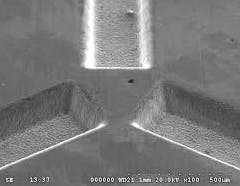Ultrashort-pulse lasers make near-perfect walls and edges possible
BILL PEATMAN
Technology eliminates cost and time of post-processing
The demand for smaller, smarter parts in the products that the world wants is driving exciting innovations in the world of laser micromachining. Advances in ultrashort-pulse (USP) laser micromachining have allowed the technology to evolve from a scientific research tool to an industrial micromachining solution (FIGURE 1).
Because the duration of femtosecond laser pulses is shorter in time than the material being machined can absorb heat, material is removed with extreme precision without any heat-affected zone (HAZ) and thermal damage to the part. Also, because light is the machining tool, it does not wear down so there is no variability from tool decay. Thermal damage and tool wear from mechanical micromachining and slower-pulsed laser machining technologies limit the precision that can be achieved, and leave side effects that require costly, time-consuming post processing.
FIGURE 2 shows micro-holes drilled with different pulse widths, from nanosecond to femtosecond regimes. Note the surface and edge quality of the femtosecond laser process, removing material HAZ or thermal damage that would need to be addressed with costly post-processing.
Emerging applications
One of the emerging applications for USP laser micromachining is creating perfectly straight, perpendicular walls for micro-parts to make intricate movements and connections possible. These features have typically been machined with wire electrical discharge machining (EDM), but in many cases superior results and faster cycle times can be achieved with ultrafast lasers.
Watch gears. Precision watches involve hundreds of intricate gears that must fit together perfectly to achieve the kind of accuracy that consumers demand (FIGURE 3). Increasing competition in the fine watch market is driving manufacturers to find more efficient manufacturing processes to achieve the kind of wall and edge integrity they need with higher yields and faster processes. USP laser technology is helping advance this industry by enabling precise cutting of any material to exact dimensions at high speeds and with no thermal damage, eliminating costly post-processing steps.
Semiconductor probe cards. Semiconductor probe card hole fabrication is one of the most grueling and technically challenging applications for any micromachining platform. Probe cards are testing sockets for the thousands of micro-scale wires and connectors on an integrated circuit. A single probe card can require 50,000 micro-holes in a 25 × 25mm area, with micron-level precision requirements. New designs for semiconductor probe cards call for different shaped sockets, including square- and rounded-corner shapes (FIGURE 4). USP laser platforms are proving capable of cutting these holes with extreme speed and precision, dramatically improving cycle times and part quality.
Micro-slots. High-precision micro-slots are critical to many applications—including microfluidic channel machining, where slots must be sized to separate fluids at molecular levels, transmitting the fluids to be extracted and tested and filtering out all others. Micro-slots are also critical features on medical devices that require precise fluid distribution, as well as micro-implantable devices. USP laser micromachining makes it possible to manufacture micro-slots with exceptional perpendicularity at production speeds (FIGURE 5), with precision ensured by integrated part validation and characterization.
Microlution, a subsidiary of GF Machining Solutions, pioneered the world's first industrial-class USP laser micromachining platform (FIGURE 6)—an in-depth discussion of this technology will appear in the January/February 2017 issue of Industrial Laser Solutions.
The ML-5 five-axis station can be configured to drill, mill, and cut with no HAZ to deliver precision parts in seconds. The station is at work in the automotive, medical, consumer product, life sciences, and semiconductor industries around the world, combining USP laser-precision material removal with exceptional stability, motion control, part handling, and integrated measurement and verification.
BILL PEATMAN([email protected]), who supplied this review of USP laser applications to ILS, is with Microlution, Chicago, IL; www.microlution-inc.com.








